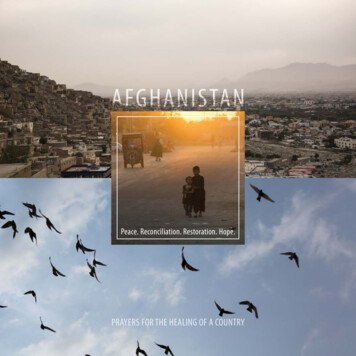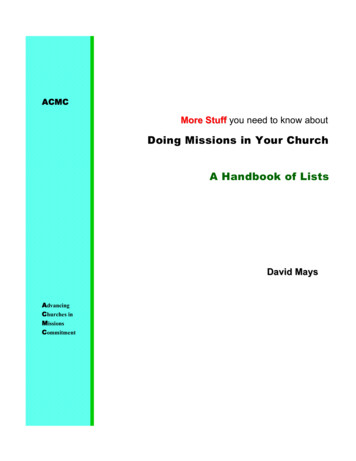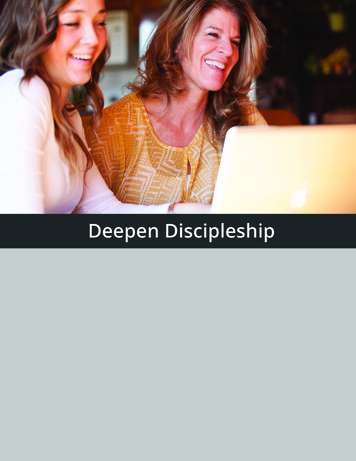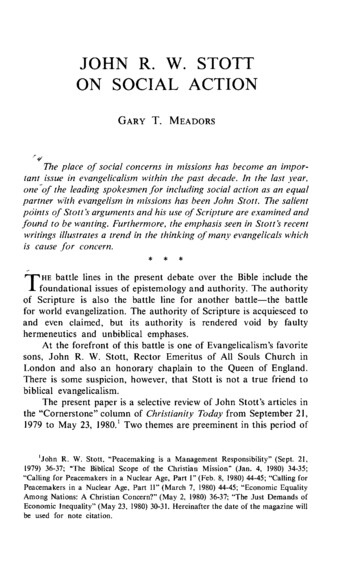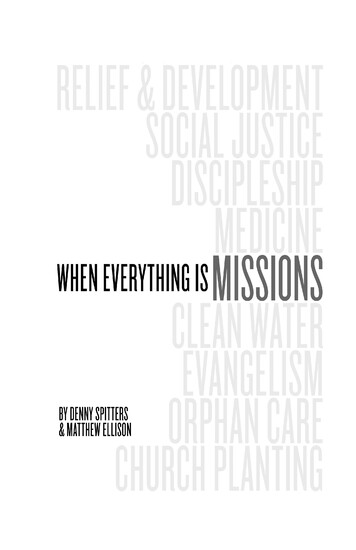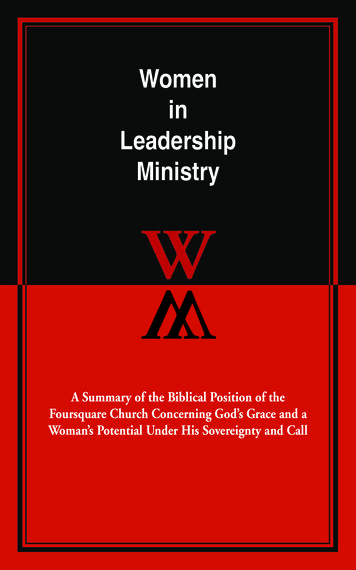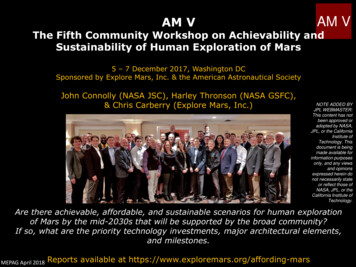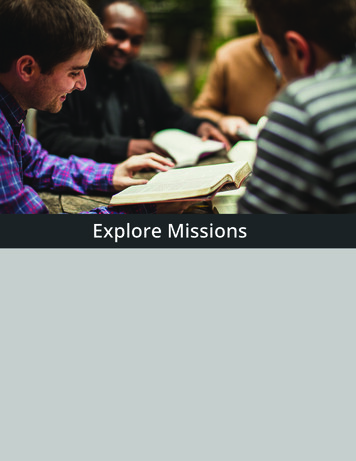
Transcription
Explore MissionsExplore MissionsIMB.org1Explore Missions
Explore MissionsCopyright 2017 International Mission BoardAll rights reserved. First printing 2017. No portion of this book may be reproduced,stored in a retrieval system, or transmitted in any form or by any means—electronic,mechanical, photocopy, recording, or otherwise—without the prior written permissionof the publisher. Contact Permissions, International Mission Board, info@.Printed in the United States of America.International Mission Board3806 Monument Avenue, Richmond, VA 23230imb.orgUnless otherwise noted, all Scripture quotations are taken from the HCSB, Copyright 1999, 2000, 2002, 2003, 2009 by Holman Bible Publishers. Used by permission. HCSBis a federally registered trademark of Holman Bible Publishers.IMB.orgExplore Missions
ContentsContents Explore Missions1 Course Contents2 Missions and the Old Testament6 Introduction: Mission from the Beginning7 Lesson 1: The Big Picture of the Bible9 Lesson 2: Missions in the Law of the Old Testament Lesson 2: God’s Promises to Abraham Lesson 3: Missions in the Psalms1719 Lesson 4: Missions in the Old Testament Prophets Lesson 5: Mission in the Book of Jonah2327 Group Discussion: Missions and the Old Testament Missions and the New Testament153136 Introduction: Four Types of New Testament Literature 37 Lesson 1: Missions and the Life and Ministry of Jesus Lesson 2: Missions in the Book of Acts3944 Lesson 3: Missions in the New Testament Letters and Revelation Next Lesson 3: Missions in Revelation4953 Lesson 4: Missions and What the Bible Teaches About the Lost55 Lesson 5: Mission and the Bible: What Is The Mission of God’s Church? Lesson 5: What is the Mission of the Church?5962v Group Discussion: Missions in the New Testament64 Being a Disciple of Jesus 73 Introduction: Essence of Following Jesus74 Lesson 1: The Central Command of the Great Commission Lesson 2: Transformed Heart and Mind81 Lesson 3: Transformed Desired and Will85 Lesson 4: Transformed Relationships and Purpose Lesson 5: The Practices of a DisciplesIMB.org3947690Explore Missions
Contents Group Discussion: Being a Disciple of Jesus What do Missionaries Do?99105 Introduction: Basic Missionary Tasks 106 Lesson 1: Engaging Those Who Have Never Heard the Gospel Lesson 1: Engaging Strategically109112 Lesson 2: Sharing the Gospel 115 Lesson 2: Principles of Contextualization119 Lesson 3: Discipling Believers 121 Lesson 4: Planting and Multiplying Churches126 Lesson 4: What Should the Church Look Like?129 Lesson 5: Training Leaders132 Group Discussion: What do Missionaries do? Our Family Story137144 Introduction: Our Family History145 Lesson 1: Missions in the Early Church148 Lesson 1: A “Christian” Empire 151 Lesson 2: Missions in the Middle Ages Lesson 2: Christianizing Europe153156 Lesson 3: Mission in the Reformation Age 161 Lesson 3: Protestant First Fruits164 Lesson 4: The Great Century of Missions167 Lesson 4: Phase Two — To the Interior171 Lesson 5: Missions in the Modern Era177 Lesson 5: Phase Three — To Every People Group 180 Group Discussion: Our Family Story 185 Missions and the World Today 192 Intro: Looking Back 193 Lesson 1: Unreached and Unengaged People Groups 195 Lesson 2: Other Religions199 Lesson 2: Building Relationships Lesson 3: Crossing Cultures212 Lesson 3: Levels of Culture214210 Lesson 3: Relating to Other Cultures 217IMB.orgExplore Missions
Contents Lesson 4: Missions and the Local Church220 Lesson 4: The Role of Churches Today222 Lesson 5: Suffering for the Gospel226 Lesson 5: Suffering as a Missionary230 Lesson 5: The Joy of Suffering 232 Group Discussion: Missions and the World Today 235 Final Charge by David PlattIMB.org2395Explore Missions
ContentsCourse OverviewWhat does Jesus want us to do? The first answer to that question, of course, is thathe wants us to repent of our sins and put our trust in him. This course is intended forpeople who have already taken that step. For those of us who know Jesus and trusthim, we know that he taught us a lot about how we are to live our lives, love otherpeople, and worship God. However, we also believe that he wants us to do thesethings in the context of a mission that he gave us—a mission we are to carry out in theworld. This course is designed to help you explore and understand that mission.Explore Missions is designed to be read in community. You should find at least oneother Explore Missions partner so that you can learn and discuss together.The course is organized into six sections, each with five lessons. We recommendworking through the content with at least one reading partner over the course of sixweeks.IMB.org1Explore Missions
Course ContentssectionCourse ContentsAn Introduction to Explore MissionsAs Christians, we believe that the Bible is the actual word of God, and we look to itas our ultimate authority. For that reason, this course will begin by exploring thesubject of missions as it is woven into the big story of the Bible. The Great Commission(Matthew 28:16-20) was not something Jesus simply tacked on as an afterthought rightbefore He went back up into heaven, but rather one of the major themes that tie theBible together. We will look through the Bible from beginning to end to see how God’splan for the nations flows through every part, and then sum it all up by looking at twocrucial questions: What does the Bible as a whole teach us about people who havenever heard the gospel, and what does it teach us about the nature of the mission Godhas given us?Course PurposeOnce we have established our understanding of missions in the big storyof the Bible, we will look at what missions actually involves. We will definemissions as disciples of Jesus making new disciples of Jesus, out of peoplesand places not yet reached with the gospel. For this reason, we will spenda full unit of lessons defining what it means to be a disciple, and then wewill spend another unit exploring the basic tasks that make up the work ofmissions. In an age where the word “missions” can mean almost anything thechurch does outside its own walls, it is very important that we understandexactly what is involved in doing biblical mission work.IMB.org2Explore Missions
Course ContentsIn Unit 5, we will get to know our family story. As adopted children of Godthrough faith in Jesus Christ, we are part of a family that goes back to the daysof the Bible, and our family history includes the history of global missionsfrom the days of the apostles to the present. From the point of view of thefirst followers of Jesus, where we live is “the ends of the earth,” and the historyof missions tells us how the gospel got from them to us. It also shows usthings that have worked well and things that have proven unhelpful in thespread of the gospel. As there really is nothing new under the sun, we needto learn from our family members in the past. In the sixth unit of lessons,we will look at missions today. We will see where things stand at this pointin the advance of the gospel, and explore issues that affect how we do thework that God has given us. Finally, David Platt, President of the InternationalMission Board, will give a challenge to you to take what you have learned anduse it to engage the world with the gospel.This course is an introduction for people who want to learn about missionsbut who have little or no background in it. The authors are practitionerswho are involved in the global spread of the Good News of Jesus, and theirexperience includes decades of working in places and among people whohave the least access to the gospel in the world. There are six units in thiscourse which may be covered in six weeks, but you may take it at whateverpace works best for you. Each unit has an introduction, five lessons to bedone during the week, and then a summary with discussion questions andexercises to be done, ideally, with a group of people who are taking thecourse together.Our goal is to do more than simply inform you about missions. Real traininginvolves not just your head, but your head, your heart and your handstogether. We want the word of God and the lostness of the world to changethe way you think, the way you feel, and what you do. For that reason, eachunit will have questions to help you understand and apply what you arestudying, and will include things for you to do with what you are learning.Our prayer is that this course will transform every area of your life.We believeIMB.org3Explore Missions
Course Contentsthat the word of God is true, and we live under its authority. By God’s grace,we have come to realize that we are rebels against God who deserve onlycondemnation, and who can never save ourselves. By His grace, we haveheard the gospel, trusted Jesus, and been saved from what we deserve.By His grace, we have been made alive by His Holy Spirit, rescued fromcondemnation, forgiven every evil we have ever done or will do, adoptedas His children, and guaranteed eternal life with Him. By His grace, we havecome to know God through our Lord Jesus Christ, and we have found Him tobe more glorious than we could ever describe. His love and a passion for Hisglory now compel us to understand His heart for the nations and his plan forhuman history. They compel us to take the Good News to those who havenever heard it. We pray that this study of missions will be a milestone in yourlife as you take your place in the purposes of God.Navigating Explore MissionsThis material was designed to be read, discussed, and experienced incommunity, and is recommended for a six-week period of study. There aresix units of five lessons each, with the intention of individual group membersreading through and considering a lesson each day (five days each week)in preparation for a group discussion meeting once per week. As you movethrough the course material, you will see that each week’s unit commenceswith a video featuring David Platt, IMB President, and an introduction, thenpresents five daily lessons to be read individually, and concludes with aGroup Discussion Guide.For example, the first week’s unit — “Missions and the Old Testament” — hasfive daily lessons: The Big Picture of the Bible Missions in the Law of the Old Testament Missions in the PsalmsIMB.org4Explore Missions
Course Contents Missions in the Old Testament Prophets Mission in the Book of JonahMost of these daily lessons are contained on one screen and only requiresome scrolling to read through on a given day. Some are a bit longer,however, and may have two pages of content. It’s easy to know which lessonyou’re on, though, as each page has a clear heading!Each unit introduction presents that week’s memory verse in an interactiveformat that will help you commit Scripture to memory, and each daily lessonconcludes with thought-questions meant to prepare the individual for weeklygroup discussion. There’s plenty to do and learn!IMB.org5Explore Missions
Missions and the Old TestamentsectionMissions and the Old TestamentIMB.org6Explore Missions
Introduction: Mission from the BeginningsectionIntroduction: Mission from the BeginningPsalm 96:3Declare his glory among the nations,his marvelous works among all thepeoples!In this unit, we are going to look at what the Old Testament teaches us about missions.This may come as a surprise to some people. After all, the Old Testament comesbefore Jesus ever gave the Great Commission.Why would we start here?There are several reasons we need to start in the Old Testament in order tounderstand the mission that God has given his New Testament people. First, the OldTestament is the foundation for the entire Bible. In the Old Testament, we learn thestories that set the plotline for the big story of Scripture. These stories include thecreation of the world, the fall of the human race into sin, Noah and the flood, andthe tower of Babel. They tell us about the beginnings of the people of God throughAbraham, Isaac, and Jacob. They tell the stories of Moses and the Exodus from Egypt,and Joshua and the conquest of the Promised Land. They give us the dismal accountof God’s people during the period of the Judges, and the glories (and tragedies) of thereigns of David and Solomon. They tell us about good kings and bad ones (mostly badones!) in the centuries after Solomon, and about the fall of Jerusalem and the exile inIMB.org7Explore Missions
Introduction: Mission from the BeginningBabylon. They give us the lives of the prophets whom God sent to call his people backto himself.The Old Testament is a book of stories, but they are not random or disconnected.Rather, they are parts of one big story that shows the hand of God preparing the wayfor the coming of Jesus and the spread of the gospel worldwide. The Old Testamentalso gives us a worldview—a worldview that is God’s view of reality. In the OldTestament, we learn that there is one and only one God. We learn that God existedbefore time began and that he is a personal God who relates in a personal way tothose he created. We learn that God made everything that exists and that everythinghe made is good. We learn that time had a beginning, that it is going somewherepurposefully, and that one day it will end. We learn that men and women were createdin God’s image and given the task of filling the earth and ruling over it. We learn thathuman rebellion against God is The Problem that lies behind all the problems we facein this world. We learn that God is a God who saves undeserving rebels. Indeed, welearn a lot about this God. We learn about his character as we watch him act in history.We learn what pleases him and what displeases him from his law. We learn abouthis justice and mercy in the sacrifices he established. The Old Testament gives us thebuilding blocks for understanding God, the world, and ourselves, and those buildingblocks are essential for understanding both the gospel and the mission God has givenus.Finally, the Old Testament shows us God’s agenda for human history. Throughout thepages of the Old Testament, we see God’s heart for all the nations and peoples of theearth, even while he focuses on the one nation of Israel. We learn about his plan tosend a Messiah, and we learn that this Messiah will have an explicitly global missionof redemption. We discover God’s intention to receive the praise and glory that aredue his Name from every people group on earth. Once we see all of this, the GreatCommission becomes more than just one more thing that Jesus told his people to do.It becomes a fitting summary of everything that God has been doing since the start oftime.IMB.org8Explore Missions
Lesson 1: The Big Picture of the BiblesectionLesson 1: The Big Picture of the BibleMission Woven Throughout ScriptureThen he said to them, “These are my words that I spoke to you while I was stillwith you, that everything written about me in the Law of Moses and the Prophetsand the Psalms must be fulfilled.” Then he opened their minds to understand theScriptures, and said to them, “Thus it is written, that the Christ should suffer andon the third day rise from the dead, and that repentance and forgiveness of sinsshould be proclaimed in his name to all nations, beginning from Jerusalem. You arewitnesses of these things.” Luke 24:44-48Jesus said these words to his followers right before he went back up into heaven. Inhis day, the Old Testament was the only Bible that God’s people had, and they dividedit into three sections: the Law of Moses, the Prophets, and the Writings. The Book ofPsalms was the largest book in the section they called the Writings, so sometimesthey just called the entire section “The Psalms” as a form of shorthand. Jesus’ wordsin these verses tell us how he understood the entire Old Testament—and indeedthe entire Bible. As far as Jesus was concerned, the Bible was not a disconnectedcollection of stories and teaching points. Instead, it was one connected story pointingto him. Specifically, it was one connected testimony to his atoning death and victoriousresurrection. Every part of the Bible of Jesus’ day—the Law, the Prophets, and theWritings—led to him. Note carefully, however, that he also regards the entire Bible aspointing to a mission that his people are to fulfill. It is written in the Law, the Prophetsand the Writings that the Messiah would suffer death and then rise again from thedead. According to Jesus, it is also written in the Old Testament that repentance andforgiveness of sins should be proclaimed in his name to all nations. The entire Bible isabout Jesus as Savior, and the entire Bible is also about missions. You cannot separatethe two.IMB.org9Explore Missions
Lesson 1: The Big Picture of the BibleThe Narrative of Scripture in Four ActsWe often read the stories of the Bible in isolation from each other. Instead, we needto read them as developments in one big story. We need to interpret each individualstory in terms of its place in that big story. That story is absolutely true, and it definesand explains everything else. What is the big story of the Bible? First and foremost,it is the story about God. He is the author, and he is the only real hero. He is before,behind, all through, and at the end of the story. The story itself has four sections orplot movements: Creation, Fall, Redemption, and Restoration. Here is how the storygoes:Act One: CreationIn the beginning, before there was anyone or anything else, there wasGod. He needed nothing and he was enormously happy as God. Out of theoverflow of his greatness and goodness, God made the entire universe outof nothing. Everything he made was good. As the climax of his creation, Godmade the first man and woman. He made them in his own image, so that theywould represent him and reflect his glory. He put them in a perfect world,and he gave them work to do, filling the earth with other mirrors of his gloryand taking care of the good world he had made. This was Act One of the bigstory: Creation.Act Two: The FallHowever, the first man and woman rebelled against God and disobeyed him.As a result of their rebellion, everything in the world was messed up. Theirrelationship with God was broken. Their relationship with each other wasalso broken. They were cast out of the perfect garden where God had placedthem at creation. They were guilty before God. Every part of their nature wascorrupted—mind, will, desires, everything. Work was now hard. Childbirth wasnow painful. Disease and natural disasters entered the world because of manIMB.org10Explore Missions
Lesson 1: The Big Picture of the Bibleand woman’s rebellion against God. Crime and war and oppression resultedfrom it as well. Death entered the world—spiritual death first, and thenphysical death as well. All of us who are descended from the first man andwoman inherited all of this. Because of the sin of our first parents, everyonein the world is born a sinner, and everyone deserves eternal condemnationfrom God. This was Act Two of the big story: The Fall of Humanity into Sin.Act Three: RedemptionHowever, God chose to mount a rescue operation to save people, eventhough none of us deserve it. This is Act Three of the big story, Redemption,and it takes up most of the Bible. Early on, the story of Noah and the floodshowed God’s justice against human wickedness, and it also showed God’smercy in saving Noah and his family through the Ark. At the Tower of Babel,God again acted in judgment against human pride by giving people differentlanguages and scattering them across the globe. At Babel, God created theincredible mosaic of different languages and people groups that make up thehuman race. That mosaic was an act of judgment on God’s part, but he thenused it as the very framework for his plan of redemption.Genesis 12 is one of the biggest turning points in the Bible. God chose Abram(later renamed Abraham) to be the father of God’s own special people, andGod promised to bless him. At the same time, God promised to bless all theother families and peoples of the world through Abraham. God repeated thatpromise, with all of its parts, to Abraham’s son Isaac, and to Isaac’s son Jacob.When Jacob and his 12 sons ended up in Egypt because of a famine, Godgrew them into a nation. When the Egyptians turned against the descendantsof Jacob (now known as Israel), God rescued them through the hand of aman named Moses. God led Israel to Sinai, where he gave them his law. Hislaw told them how to live in a way that pleases God, and it also gave them asystem of priests and sacrifices to deal, symbolically, with the fact that theyIMB.org11Explore Missions
Lesson 1: The Big Picture of the Biblewere still sinners. After Moses died, God led his people Israel to conquerthe Promised Land of Canaan through the hand of Joshua. After a periodof centuries when God governed and rescued his people through different,unrelated Judges, he gave them a king named David, and God promisedDavid that one of his sons would always sit on his throne. David was a greatking, and his reign was a high water mark for the people of God.Israel in the Old TestamentThe Divided Kingdom of IsraelHowever, in the years following David and his son Solomon, the nation ofIsrael was divided in two, and the people of God went through a vicious cycleof rebellion against God followed by partial repentance and restoration.God sent prophets to warn his people and to call them back to obedienceand faith in him. Finally, God brought judgment on his people. The Assyriansconquered the northern kingdom of Israel in the eighth century BC, and thesouthern kingdom of Judah fell to the Babylonians about a century and a halflater. The people were taken into exile. Their lives and their country wereshattered. However, God again had mercy on them. He allowed a portion ofhis people to return to their own land and to rebuild the temple where hewas worshiped. However, they were now under the heel of foreign rulers,and many of their people remained in exile, scattered across the knownworld. There was no longer a king sitting on David’s throne. Where had God’spromise gone?All throughout the history of Israel, God had spoken through the prophets,and he had told his people that an incredible day was coming—the Day of theLord. On that day, God would change people’s hearts so that they wanted todo what pleases God. The Day of the Lord would be the day the Holy Spiritwas poured out on God’s people. He would send the ultimate priest whowould offer the ultimate sacrifice, a sacrifice that really would take away sins.He would send the ultimate king, David’s eternal son, who would rescue andrule his people. The Day of the Lord would be the day of the Messiah. HeIMB.org12Explore Missions
Lesson 1: The Big Picture of the Biblewould also draw the other nations to salvation, in fulfillment of his promisesto Abraham, Isaac and Jacob. The Day of the Lord would be the day ofmissions, the day of the ingathering of the nations.All of that was fulfilled by Jesus. He was the second Adam, who won whereAdam failed and who gave the human race a new start. He was the ultimateprophet, the ultimate priest, the ultimate sacrifice, and the ultimate king. Theprophets, priests, sacrifices and kings of the Old Testament had simply beensignposts pointing to him. He lived the life we should have lived and then diedthe death we deserve to die, in our place, as our substitute. He satisfied thewrath of God that we deserved and reconciled us to himself. He poured outhis Holy Spirit on his followers to give them power to be his witnesses to theends of the earth. We are now living in the age that he started when he sentthem out to make disciples out of all nations. This is the Age of Missions, andGod’s purpose is to call a people to himself from every tribe, tongue, peopleand nation, using us as his witnesses.Act Four: RestorationThis age will not last forever. One day Jesus will return, and he will bringhistory to a close. Everyone who has ever lived will be judged accordingto their record. For those who have not trusted in Jesus, their record willjustly condemn them, and they will suffer the eternal punishment that weall deserve. For all who have trusted in Jesus, his record will be credited tothem, and they will be judged on that basis. They will enter into eternal joy inhis presence. Heaven and earth will pass away, and God will bring in the newheavens and the new earth, where righteousness dwell. This is the fourth andfinal act of the big story: Restoration.IMB.org13Explore Missions
Lesson 1: The Big Picture of the BibleFOR GROUP DISCUSSION:Answer the question(s) below in preparation for group discussion.Question 1:Have you ever thought of the Bible as one connected story? How does this affect yourunderstanding of Scripture?Question 2:How did the different peoples and language groups of the world come into being?What role do they play in God’s plan?Question 3:What was God’s promise to Abraham? How does that connect to Jesus? How does thatconnect to missions?IMB.org14Explore Missions
Lesson 2: Missions in the Law of the Old TestamentsectionLesson 2: Missions in the Law of the OldTestamentGod’s Blessing from the NationsNow the LORD said to Abram, “Go from your country and your kindred and yourfather’s house to the land that I will show you. And I will make of you a great nation,and I will bless you and make your name great, so that you will be a blessing. I willbless those who bless you, and him who dishonors you I will curse, and in you allthe families of the earth will be blessed.” Genesis 12:1-3The first five books of the Old Testament are known as “The Law.” Written by Moses,they set the foundation for the rest of the Bible. These books contain the story ofcreation and the history of the world through the Great Flood, the Tower of Babel, thelives of Abraham, Isaac and Jacob, and the exodus of the Israelites from captivity inEgypt. They also contain God’s instructions to his people on how they are to live andhow they are to worship him. How is the theme of missions woven into all of this?First of all, the setting for missions is laid in the early chapters of Genesis, the firstbook of the Bible. The rebellion of the entire human race against God is the reasonthis rescue operation is even needed. Because of the sin of Adam and Eve, every singleperson in the world is a sinner who needs to be saved, and none of us can rescueourselves. This reality tells us just how serious the situation really is, and it also showsus that this mission has to extend to everyone in the world. The division of the worldinto languages and people groups in Genesis 11 sets the framework for how Godwill go about his mission. At the tower of Babel, God divided the world into differentlanguage groups as an act of judgment. In Genesis 12, God chose one man, Abraham,to create a new people group, but he expressly said that his intention in doing so wasto bless all the peoples of the world. Later in the Old Testament, God stated his desireIMB.org15Explore Missions
Lesson 2: Missions in the Law of the Old Testamentto be worshiped in all the languages he had created and to save people out of allthe people groups he had scattered around the world. Jesus sent his followers to allpeople groups in the Great Commission (Matthew 28:18-20.) At Pentecost (Acts 2), Godpartially reversed the curse of Babel when everyone present heard the praises of Godin their own language. In the scene around the throne of God at the end of the Bible(Revelation 7), we are told that God will be worshiped by a multitude no one can countfrom every tribe, tongue, people and nation. Genesis begins the theme of the nationsor people groups of the earth, and it will be a key theme throughout the rest of theBible.Genesis also tells us the story of Abraham, Isaac and Jacob. These three men, father,son, and grandson, are absolutely key to the story of the Bible. Abraham (or Abram, ashe was originally known) was born into a pagan family in the Middle East, in the areacurrently known as Iraq. When God called Abraham, it was a call to leave everything hehad ever known, including his family, his home, and his religious background, to followGod to a place he had never seen.IMB.org16Explore Missions
Lesson 2: God’s Promises to AbrahamsectionLesson 2: God’s Promises to AbrahamIn Genesis 17, God made a covenant with Abraham. Notice the specific things Godasked, and the things God promised to him:We also need to be clear that we’re not saying that God’s interaction with Abraham isnormative for how he interacts with all of his people today. God called Abram to leave everything behind. God called Abram to go to a land that God will show him, and God didn’t even tellAbram yet where that place is. God promised to make Abram (who did not yet have any children) into a greatnation. God promised to bless Abram, without specifying exactly how. God promised to make Abram’s name great. God promised to make Abram himself a blessing to others. God promised to treat others as they have treated Abram. God promised that through Abram, all the families of the earth would be blessed.Both the demands and the promises of God’s call were breathtaking. With this call,God narrowed his focus onto one single man, but in doing so he clearly stated hisintention to bless all the peoples of the world. Abraham was blessed to be a blessing,and that blessing was intended to go global. The New Testament makes it clear thatthe coming of Jesus, and the global mission of his church, are the ultimate fulfillment ofthis promise. (Romans 4:1-25, Galatians 3:1-18).God repeated his promise to Abraham in Genesis 22:17-18. He made the samepromise to Abraham’s son Isaac: “In your offspring all the nations of the earth willbe blessed” (Genesis 26:4). He made it again to Isaac’s son Jacob: “In you and yourIMB.org17Explore Missions
Lesson 2: God’s Promises to Abrahamoff
Missions and the Old Testament 6 Introduction: Mission from the Beginning 7 Lesson 1: The Big Picture of the Bible 9 Lesson 2: Missions in the Law of the Old Testament 15 Lesson 2: God’s Promises to Abraham 17 Lesson 3: Missions in the Psalms 19 Lesson 4: M
